Readings Newsletter
Become a Readings Member to make your shopping experience even easier.
Sign in or sign up for free!
You’re not far away from qualifying for FREE standard shipping within Australia
You’ve qualified for FREE standard shipping within Australia
The cart is loading…






Compares the nature and extent of changes in social welfare programs and labor markets in nine industrialized countries. Particularly in the 1990s, social welfare programs have been cut back in a number of countries. Indeed, the phrases ending welfare as we know it or dismantling the welfare state have been used to describe this trend. In this analysis by well-recognized social welfare scholars, the nature and extent of changes in social welfare programs in key industrial or post-industrial countries is scrutinizeo. Determining if and how social welfare and employment prospects have been cut back in the United States, Canada, Sweden, the United Kingdom, France, Germany, Italy, Hungary, and Japan helps to identify the population groups hardest hit by cutback. In the United States, for example, poor, single-mother families have suffered major reductions in income support, while more powerful groups have avoided major losses. This cross-national study not only sheds light on general trends in social welfare but also provides clues to what constitutes successful reform and what has failed. This major comparative analysis will be of interest to scholars, students, policy makers, and professionals as well as the general public concerned with social welfare issues, full employment, poverty, and economic inequality.
$9.00 standard shipping within Australia
FREE standard shipping within Australia for orders over $100.00
Express & International shipping calculated at checkout
Compares the nature and extent of changes in social welfare programs and labor markets in nine industrialized countries. Particularly in the 1990s, social welfare programs have been cut back in a number of countries. Indeed, the phrases ending welfare as we know it or dismantling the welfare state have been used to describe this trend. In this analysis by well-recognized social welfare scholars, the nature and extent of changes in social welfare programs in key industrial or post-industrial countries is scrutinizeo. Determining if and how social welfare and employment prospects have been cut back in the United States, Canada, Sweden, the United Kingdom, France, Germany, Italy, Hungary, and Japan helps to identify the population groups hardest hit by cutback. In the United States, for example, poor, single-mother families have suffered major reductions in income support, while more powerful groups have avoided major losses. This cross-national study not only sheds light on general trends in social welfare but also provides clues to what constitutes successful reform and what has failed. This major comparative analysis will be of interest to scholars, students, policy makers, and professionals as well as the general public concerned with social welfare issues, full employment, poverty, and economic inequality.